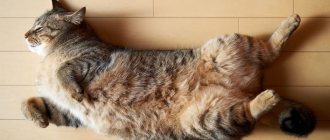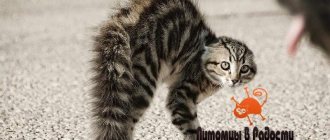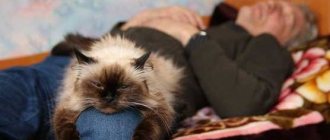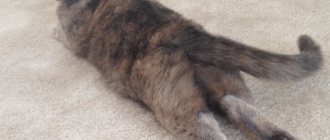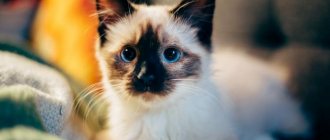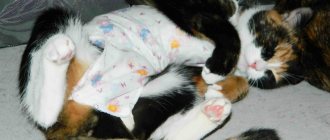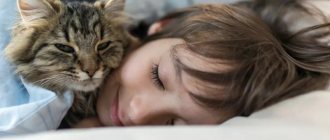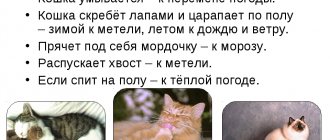To keep warm, most cats curl up into a ball and cover their face with their paws, but in addition to this popular pose, there are others. Of particular interest is the paws-up position, when the pet's belly is open for everyone to see.
This position makes the animal more vulnerable, and the owners are sincerely perplexed why some cats like to lie down and even sleep on their backs. In addition to complete trust in the owner, there are other reasons, including pathological ones.
What does it mean if a cat sleeps on its back?
A cat's tummy is the most vulnerable and sensitively protected part of the body. Mustached pets avoid his stroking at the level of reflexes, so a very small part of them do not resist the caresses of their owner.
After falling asleep, defenselessness increases. Knowing this, the animals arrange themselves in a ball or “loaf” in advance, minimizing the number of zones for a possible attack. But there are exceptions due to one of the reasons listed below.
INTERESTING!
Cats spend most of their time “recharging” in a state of dozing, immediately reacting to any suspicious rustle.
Trusts
In safe conditions, mustachioed pets instinctively roll over onto their backs out of simple convenience. The love for this position comes from childhood, when a mother cat would turn her babies over and lick their bellies before bed. Such washing not only stimulated intestinal motility, but also relaxed.
If your pet often falls asleep in a similar position next to you, then he trusts you infinitely and is not afraid of a sudden attack. It's not easy to earn this attitude, so you can be proud of yourself.
He's feeling hot
Another reason is high room temperature. An open belly and legs spread out to the sides speed up the cooling process.
In hot weather, animals try to sleep on tiles or the ground. Their breathing rate also increases, because the evaporation of saliva contributes to a faster decrease in body temperature.
Like humans, cats have sweat glands in completely hairless or almost hairless areas. The catch is that there are only 2 of them: the muzzle and the paw pads. Because of this, wet prints often appear on the floor in hot weather.
INTERESTING!
Thick fur impairs natural cooling. Because of this, cats with long hair and dense undercoat most often roll over onto their back.
Relieves pain
In case of health problems, the sleep position in question becomes forced. It relieves discomfort in the following conditions:
- arthritis (pressure on the paws decreases);
- headaches (blood flow to the brain is normalized by stretching the spine in a straight line);
- diseases of the gastrointestinal tract and banal overeating (the load on the stomach decreases).
If the reason lies in stomach pain, then any touch for the purpose of inspection can result in aggression on the part of the disturbed animal. In this case, you should contact your veterinarian.
Why cats lie on their backs but don't sleep
Before directly analyzing the situation, it is important to verify the fact of the dream. If the cat is lying on its back, but is awake, then its position will be explained by completely different reasons.
Defend against attack
Despite the vulnerability of the tummy, in a certain position its demonstration becomes part of a defensive posture. If the cat feels uneasy around other pets or strangers who have come to visit, then it can lie on its back with its claws extended. From this position it is convenient to attack with paws and teeth.
playing
When in a playful mood, cats often roll from side to side, trying to grab something with their paws. In this way they demonstrate the hunting instinct, so you should not touch the belly with your bare hands or feet.
Instead, it is recommended to throw a toy mouse, ball or plush toy into your pet's paws. After that, he will happily begin to bite her and kick her with his hind legs.
Attract attention
Cats are famous manipulators. They quickly remember the habits and reactions of their owners to certain actions. What causes delight and tenderness is noticed with particular interest: meowing in response to human speech, a plaintive look, graceful stretching and demonstration of a fluffy belly. Pets skillfully use all this to extort treats and attention to themselves.
“ If your cat is in the mood for affection and demonstrates good nature with her entire appearance, then do not wait for her to change her mind and take advantage of the moment.
Overate
Inactive neutered pets are most prone to overeating. To avoid obesity, their diet must be constantly monitored. If you do not comply with the daily caloric intake and feed your pet out of pity, then he may have serious digestive problems.
Frequent overeating slows down the digestion of food. Its excess accumulates in the stomach and stretches its walls, causing pain and heaviness. Trying to eliminate the discomfort, the cat lies on its back and tucks its paws. This position reduces pressure on the stomach that is overloaded with food.
Cats in heat
At puberty, cats begin to loudly call for the cat, raise the back of their body and roll on the floor on their back. There is no point in scolding your pet for night concerts. Estrus is a natural process that encourages an animal to take certain actions, regardless of desires.
Behavior can deteriorate for the worse even in the most obedient mustaches. Try to be patient and be sure to sterilize your pet if you do not plan to breed kittens.
A similar problem can bother the male. During sexual hunting, discomfort occurs in the groin due to increasing arousal. It is unrealistic to satisfy him without mating, but it is quite possible to weaken the sensations. This is facilitated by the position with the belly up. Despite its effectiveness, here it is also better to turn to castration, since it gives not a temporary, but a permanent result.
Big belly bothers me
This problem occurs not only in overfed animals, but also in frankly fat ones, as well as pregnant women. In the latter case, kittens increase the load on internal organs. They make it difficult for the mother to breathe, so the only comfortable position is lying on her back.
INTERESTING!
Separating kittens from their mother too early affects their sleeping position. Such babies grow up less confident and very rarely show their belly.
How cats talk to us
Cats and cats communicate with each other using body movements and smells, rarely using sounds. When we are around people, they notice that we respond better to their voice than to body language.
Cats communicate with each other using body language and smells.
Therefore, animals change their communication style to exploit human strengths and weaknesses.
Our pets view us as surrogate mothers and use their voices to tell us what they want. A little kitten, meowing, tells its mother that it feels bad. As adults, cats actively use this to communicate with people.
Types and meaning of cat talk
To express its emotions with its voice, a pet always pronounces exactly those sounds that are suitable for a given situation. They differ in strength and timbre (high or low). Any trouble is expressed by low sounds, and peace and pleasure are expressed by high sounds.
Meowing in the form of a long “meow” is a greeting to the owner who has returned home or a request, and sometimes a complaint. The short “me” means confusion or question. The goal of any “meow” is to attract the attention of others. If the owner does not respond to the first polite “meow”, the cat will ask more demandingly and loudly in order to achieve results.
Vowel sounds in different keys are a cat’s request:
- “I want to go outside”;
- “it’s time to eat”;
- "I'm upset";
- "I'm in pain."
A very loud cry from a cat is a sign of panic, a warning to owners about mortal danger in the event of a fire, earthquake or other disaster. Sometimes a pet mourns the death of a friend or moving to a new home with this cry.
Many owners have paid attention to “silent meowing,” when a cat, looking at a person, opens its mouth, but there is no sound. In fact, it exists, but in the ultrasonic range, which only animals can hear. But a person more often reacts to such a quiet “meow”, and the cat notices this and uses it with might and main.
Purring (special cooing sounds) shows the calm state of the cat, without aggression. He is happy with everything. Mother cats purr for kittens: everything is fine, there is no danger. This is how a pet shows its affection for its owner. He is happy when petted, purrs and squints his eyes. If he follows you around, tries to climb onto your lap, brings you a toy or food - this is also a sign of his love. When he rubs his head against your legs or “butts” his forehead, massages with his paws, licks your hand and sits next to you if you are sick - do not doubt that you are more important to him than anything in the world.
By purring, the cat shows that he is happy and loves you.
If dissatisfied, the cat purrs in low tones, warning that you are interfering in its affairs. Hisses when scared, but does not dare to attack. If he snorts and moves forward when meeting an enemy, he is ready for a fight. With a loud howl, he tries to break the enemy’s fighting spirit so that he retreats first.
Scientists have found that cats can produce hundreds of different sounds, and at least 15 of them are meows. Among them there are consonants: “g”, “v”, “f”, “r”, “m”, “n”. There is even a “Dictionary of Cat Language”, which includes more than 3 thousand “words” and “concepts” for different breeds of cats.
Cat body language and body language
In addition to sounds, cats communicate with each other and with people using gestures and different positions of their bodies. The main tools for expressing emotions are the tail, eyes and ears.
Body position indicates mood, and maximum anger and intimidation before a fight can be accompanied by a howl or growl
"Tail" emotions
Tail movements show a cat's mood:
- wagging the tip of the tail is a sign of curiosity or irritation, sometimes sadness;
- if the tail whips up and down quickly, there is strong excitement;
- the tip of the tail rotates - it will defend itself;
- a triumphantly raised tail signifies friendliness and joy;
- the tail is tucked between the hind legs when frightened;
- the tail is lowered and ruffled in case of danger.
Eyes and ears
With wide open eyes, the cat shows curiosity, looks straight ahead - ready for battle, and his pupils sharply constrict if he is angry. Half-closed eyes indicate peaceful relaxation.
When the cat is completely relaxed, he stretches and looks at the world with half-closed eyes.
You can tell by the position of the ears when the cat is scared and trying to threaten. In this case, they are pulled back and pressed against the head.
If during a game the cat is discouraged by what he sees and cannot find an explanation, this can be seen from the expression of his face
If the ears twitch nervously, this means irritation and readiness to fight back. Vertical - study.
Curiosity is indicated by wide eyes and erect ears.
If a cat is dozing with his eyes closed and his ears moving in different directions, this is a skillful pretense; in fact, he is listening carefully to your conversation.
Emotional mustache
When a cat is happy and calm, his whiskers cheerfully stick out in all directions. They twitch while tracking prey. If the cat is interested in something, they are directed forward. Tranquility is reflected by the mustache flowing freely on the sides of the head.
Cats are very resourceful. If your pet notices that a certain “meow” is working, he can try a new sound and gauge the reaction of others. Talking to a person about yourself is a sign of friendship and sympathy.
Is it possible to stroke your belly at such moments?
Everything here is very individual. Based on the circumstances and character of your pet.
Active twitching of the paws and antennae is characteristic of the dreaming phase. Touching at such a moment can awaken and frighten the animal, provoking a defensive attack. Also, stroking should be avoided when the pet is already at the ready with its claws extended or is trying to digest what it has eaten with pain in its eyes.
If your pet is as tactile as possible, then you can touch it under almost any circumstances. Caution should be exercised only in case of painful sensations and during play, when your arms and legs are perceived as prey.
What should you be wary of?
You can’t beat a cat even as a joke - it will remember, be offended and take revenge.
An animal can clearly signal its condition. It should especially frighten the owner when the cat sits for a long time with its forehead pressed against the wall. She cannot say that she has a severe headache, and she vitally needs the help of a veterinarian. When animals poke their noses into your hands, it is a request for help. Intermittent breathing with an open mouth - fatigue from extreme heat, a way to cool down and relax. The whitish membrane of the eye is visible - you need to leave your pet alone and let him sleep.
